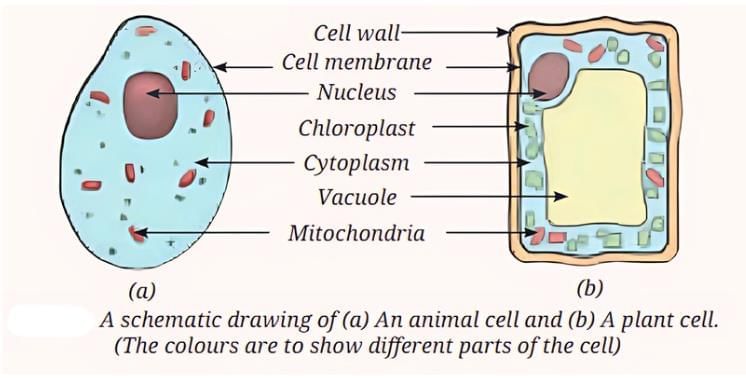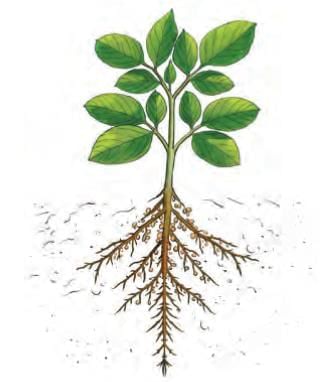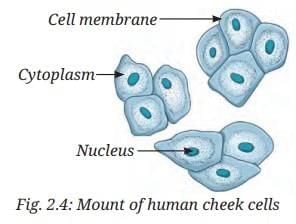Important Diagrams: The Invisible Living World: Beyond Our Naked Eye | Science Curiosity Class 8 - New NCERT PDF Download
Q1: Answer the following Questions based on the diagram given below:
(i) What is the main function of the cell membrane in both cells?
Ans: The cell membrane controls what goes in and out of the cell. It protects the cell and helps keep the inside of the cell balanced and safe.
(ii) Define the role of the cell wall.
Ans: The cell wall is a rigid outer layer of plant cells that provides strength, support, and shape, helping the plant cell maintain a firm structure.
(iii) What is the function of the mitochondria in both animal and plant cells?
Ans: The mitochondria make energy for the cell. They break down food and release energy that the cell uses to grow, move, and work properly.
(iv) Which of the following components is present only in the plant cell?
(a) Nucleus
(b) Cytoplasm
(c) Chloroplast
(d) Cell membrane
Ans: (c) Chloroplast
Chloroplasts contain chlorophyll and are used for photosynthesis in plant cells; they are absent in animal cells.
(v) What is the significance of the cell structures shown in the diagram for the survival of organisms?
Ans: The structures help the cell perform essential functions:
- Nucleus – controls cell activities
- Cell membrane – regulates entry and exit of substances
- Chloroplasts – carry out photosynthesis in plants
These functions are important for growth, energy production, and survival of the organism.
Q2: Answer the following Questions based on the diagram given below: Root Nodules of Cowpea plant which contain Rhizobium
Root Nodules of Cowpea plant which contain Rhizobium
(i) What is the role of the structures shown in the diagram on the roots of the cowpea plant?
Ans: The root nodules contain Rhizobium bacteria, which convert atmospheric nitrogen into compounds that the cowpea plant can use, helping the plant grow and improving soil fertility.
(ii) Define nitrogen fixation.
Ans: Nitrogen fixation is the process by which Rhizobium bacteria in root nodules convert atmospheric nitrogen into ammonia or other compounds that plants can use for growth.
(iii) How does the relationship between the cowpea plant and Rhizobium bacteria work?
Ans: The diagram shows root nodules on the cowpea plant, indicating a symbiotic relationship: Rhizobium bacteria supply nitrogen to the plant, and the plant provides shelter and nutrients to the bacteria.
(iv) Which of the following microorganisms is shown in the diagram as residing in the root nodules?
(a) Lactobacillus
(b) Rhizobium
(c) Yeast
(d) Amoeba
Ans: (b) Rhizobium
These bacteria fix nitrogen in the root nodules of cowpea plants.
(v) What is the significance of the process shown in the diagram for agriculture?
Ans: Nitrogen fixation enriches the soil with nitrogen, reduces the need for chemical fertilizers, promotes healthy crop growth, and supports sustainable farming.
Q3: Answer the following Questions based on the diagram given below:

(i) What is the outermost layer of the human cheek cell shown in the diagram?
Ans: The outermost layer of the human cheek cell is the cell membrane.
(ii) Name the part of the cell that contains the genetic material and is labeled in the diagram.
Ans: The part of the cell that contains the genetic material is the nucleus.
(iii) What is the function of the cytoplasm in a human cheek cell?
Ans: The cytoplasm is the jelly-like substance inside the cell membrane where various cell organelles are suspended and where many cellular processes take place.
(iv) What type of cell is shown in the diagram of the human cheek?
Ans: It is an animal cell because it does not have a cell wall or chloroplasts.
(v) Why do human cheek cells appear to be clustered together in the diagram?
Ans: Human cheek cells appear clustered together because they are part of a tissue and are naturally found in close proximity to each other in the cheek lining.
|
59 videos|236 docs|13 tests
|
FAQs on Important Diagrams: The Invisible Living World: Beyond Our Naked Eye - Science Curiosity Class 8 - New NCERT
| 1. What is the microscopic world and why is it important in understanding life? |  |
| 2. How do scientists study organisms that are invisible to the naked eye? |  |
| 3. What are some common examples of microorganisms and their roles in the environment? |  |
| 4. Why is it essential to study the invisible living world in relation to human health? |  |
| 5. How has the understanding of microorganisms evolved over time? |  |
















